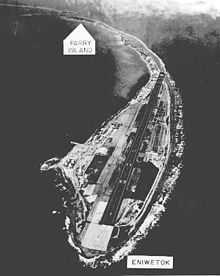Unsinkable aircraft carrier

An unsinkable aircraft carrier is a term sometimes used to refer to a geographical or political island that is used to extend the power projection of a military force. Because such an entity is capable of acting as an airbase and is a physical landmass not easily destroyed, it is, in effect, an immobile aircraft carrier that cannot be sunk.
The term unsinkable aircraft carrier first arose during World War II, to describe the islands and atolls in the Pacific Ocean which became strategically important as potential airstrips for American bombers in their transoceanic war against Japan. To this end, the US military engaged in numerous island hopping operations to oust the occupying Japanese forces from such islands; the US Navy Seabees would often have to subsequently construct airstrips there from scratch — sometimes over entire atolls — quickly, in order to support air operations against Japan.
Malta and Iceland[1] was sometimes described as an unsinkable aircraft carrier during World War II, making it a target of the Axis powers. The US military is said to have considered Taiwan since the Chinese Civil War, and the British Isles and Japan during the Cold War, as unsinkable aircraft carriers.[2][3] In his 1984 fiction novel, George Orwell referred to England as Airstrip One. In 1983, Japanese Prime Minister Yasuhiro Nakasone, pledged to make Japan an "unsinkable aircraft carrier in the Pacific", assisting the US in defending against the threat of Soviet bombers.[4][5] US Secretary of State, Gen. Alexander Haig said that Israel is "the largest American aircraft carrier in the world that cannot be sunk."[6]
During the Second World War Britain gave some serious thought to building virtually unsinkable aircraft carriers from ice reinforced with sawdust (Project Habakkuk). A model was made, and serious consideration was given to the project, with a design displacing 2.2 million tons and accommodating 150 twin-engined bombers on the drawing board, but it was never produced.
See also
References
- ↑ ICELAND. SOME HISTORICAL REMARKS
- ↑ Blystone, Richard. "Europe learning lessons of Greenham Common". CNN. Archived from the original on 2008-07-26. Retrieved 2007-12-18.
- ↑ "An unsinkable aircraft carrier". Time. 1950-09-04. Retrieved 2007-12-18.
- ↑ Smith, William E; McGeary, Johanna; Reingold, Edwin M. (1983-01-31). "Beef and Bitter Lemons". Time. Retrieved 2007-12-18.
- ↑ Sanger, David E (1995-05-14). "The Nation: Car Wars; The Corrosion at the Core of Pax Pacifica". The New York Times. Retrieved 2007-12-18.
- ↑
- Hanson, Richard (2004-02-07). "'Unsinkable aircraft carrier' steams to Iraq". Asia Times (Hong Kong, ZH). Retrieved 2007-12-18.